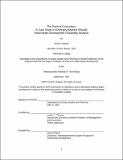| dc.contributor.advisor | Lester C. Thurow. | en_US |
| dc.contributor.author | Clayton, Paul B., S.M. Massachusetts Institute of Technology | en_US |
| dc.contributor.other | Massachusetts Institute of Technology. Dept. of Urban Studies and Planning. | en_US |
| dc.date.accessioned | 2008-09-02T17:49:08Z | |
| dc.date.available | 2008-09-02T17:49:08Z | |
| dc.date.copyright | 2007 | en_US |
| dc.date.issued | 2007 | en_US |
| dc.identifier.uri | http://hdl.handle.net/1721.1/42014 | |
| dc.description | Thesis (S.M. in Real Estate Development)--Massachusetts Institute of Technology, Dept. of Urban Studies and Planning, 2007. | en_US |
| dc.description | This electronic version was submitted by the student author. The certified thesis is available in the Institute Archives and Special Collections. | en_US |
| dc.description | Includes bibliographical references (p. 135-144). | en_US |
| dc.description.abstract | In 2003, Renata Oliveira, a young Portuguese architect, has re-discovered the Point of Corumbau in Bahia, Brazil, and, like the Portuguese adventurers who had discovered Brazil 500 years earlier in the same location, found it to be an area that is wild, beautiful and undeveloped. It is also sitting right at the edge of perhaps the most promising resort and second home real estate market in the world: the Northeast coast of Brazil. The case challenges students to conduct market and project feasibility analysis in an emerging market environment, with data and contextual information supplied in the case. It considers the effectiveness of such analysis, and raises questions about the usefulness of time-series data in markets that are changing in fundamental ways, the importance of macro- and international economics in weighing real estate investments, the methods available for evaluating emerging market risk, the challenges of managing development and construction in a foreign environment, and the role, if any, for a developer's personal vision in the value creation system. Part II of the case allows students to re-consider these questions in the light of subsequent events. At the same time, the case examines two of the most exciting real estate markets in the world today: Southeastern Brazil's urban housing market, and the resort and vacation home market of the coastal Northeast. | en_US |
| dc.description.statementofresponsibility | by Paul B. Clayton. | en_US |
| dc.format.extent | 188 p. | en_US |
| dc.language.iso | eng | en_US |
| dc.publisher | Massachusetts Institute of Technology | en_US |
| dc.rights | M.I.T. theses are protected by
copyright. They may be viewed from this source for any purpose, but
reproduction or distribution in any format is prohibited without written
permission. See provided URL for inquiries about permission. | en_US |
| dc.rights.uri | http://dspace.mit.edu/handle/1721.1/7582 | en_US |
| dc.subject | Urban Studies and Planning. | en_US |
| dc.title | The point of Corumbau : a case study in emerging market (Brazil) real estate development feasibility analysis | en_US |
| dc.title.alternative | Case study in emerging market (Brazil) real estate development feasibility analysis | en_US |
| dc.type | Thesis | en_US |
| dc.description.degree | S.M.in Real Estate Development | en_US |
| dc.contributor.department | Massachusetts Institute of Technology. Department of Urban Studies and Planning | |
| dc.identifier.oclc | 226318592 | en_US |
